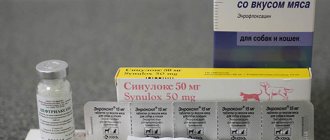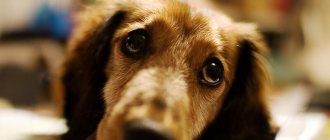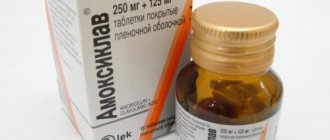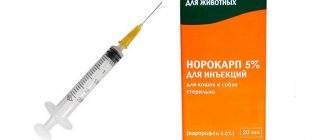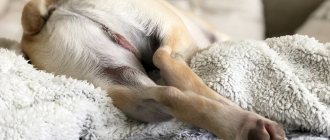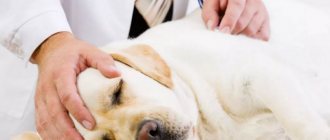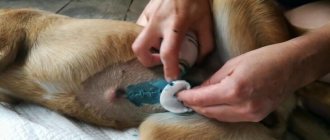Active dogs sometimes get into dog fights. Therefore, you need to know what to do if your dog gets into a fight while walking. Even a well-mannered dog can become a victim of a pack of stray dogs, which sometimes attack pets in a pack. As a result, the dog’s wound may take a long time to heal and be a reminder of the unpleasant incident. To prevent this from happening, choose safe routes and parks for walking.
Treating wounds in dogs requires a lot of patience from both the dog and its owners. If your pet is injured, do not panic, do not cry or scold your dog.
If there is an owner next to the dog that bit your pet, ask if the dog has a veterinary passport and a current rabies vaccination. Typically, the consequences of such dog fights are bitten and lacerated wounds. Every dog owner needs to know how to provide first aid to a pet.
First, you need to assess the nature of the wound, how big it is, determine whether there is bleeding, if so, what kind of bleeding it is and how strong. If the wound turns out to be minor, then it will need to be treated with an antiseptic. If it is of a serious nature (there are bites, torn edges, etc.), then you must urgently consult a veterinarian!
Sequence of actions, first aid:
- Shave or trim the fur around the injury.
- If dirt gets into the wound, after removing the hair, wash the wound with antiseptics.
- Disinfect with hydrogen peroxide solution or chlorhexidine. If there are no medications nearby, use running water.
- Penetrating trauma to the chest or abdominal cavity - immediately take the animal to the veterinary clinic. A specialist will tell you how to treat a dog’s wound. You need to try to stop the bleeding, disinfect the injured area, and apply a bandage.
After providing first aid, immediately contact a veterinary clinic, where the doctor will examine the animal, perform surgical treatment of the wound,, if necessary, apply stitches or install a drainage system, and prescribe a course of antibiotic therapy.
Do not neglect a professional examination, even if in your opinion the wound is trivial. In most cases, after poor-quality treatment and incorrect actions on the part of the owner, complications occur in the form of abscesses, wound decay, sepsis and long healing.
In the case of wounds accompanied by bleeding, untimely assistance can cost the life of your pet.
Side effects
If the instructions are followed, not all dogs develop negative reactions. Despite the list of possible side effects indicated in the instructions, a four-legged pet can safely tolerate antibiotic therapy if the treatment rules are followed.
The annotation for the drug indicates possible negative reactions that the dog owner should be aware of. Be sure to describe to the veterinarian all diseases and conditions, the presence of which can lead to complications and negative consequences in a particular animal.
Possible side effects of antibiotic therapy:
- dysbacteriosis;
- decreased immunity;
- allergic reactions;
- vomit;
- nausea;
- the fur becomes dull, thins, and sometimes falls out;
- a depressed state and drowsiness appear;
- coordination of movements worsens;
- development of seizures;
- local reactions when receiving injections;
- constipation or diarrhea;
- disruption of the course of pregnancy (mainly due to improper use of drugs).
Factors that provoke the development of side effects: overdose, increased sensitivity to the drug in an animal, incorrect selection of an antibiotic in the treatment of a serious illness. Reduces the risk of dysbiosis using probiotics and dietary supplements for dogs: FortiFlora, Lactoferon, Lactobifid.
What ointments are used to treat wounds?
The owner should always have Chlorhexidine solution, Levomekol, Ranosan ointment, or any other ointment with a wound-healing effect, bandages, and napkins on hand to provide first aid. Other drugs are prescribed by the attending physician depending on the specific case.
If you go hunting or on a multi-day hike with your dog, it is better to take the necessary medications with you than to think later about how to help your pet. It is worth remembering that the animal’s wound should always be washed thoroughly, without leaving hair, dirt, crusts, etc. in it. otherwise, all treatments will only be harmful, and the wound will soon begin to fester.
Indications for the use of antibiotics
Direct indications for taking antibacterial agents are microbial and fungal diseases. Antibiotics will not help against viruses or parasites. Veterinarians prescribe antimicrobial drugs in the following cases:
- Abscesses, pustules, open or closed wounds with purulent accumulations;
- Bacterial infections of the genitourinary system (Cystitis, metritis, urethritis);
- With inflammation of the kidneys (Pyelitis, pyelonephritis);
- Bronchitis, tonsillitis, pulmonary pneumonia, rhinitis;
- E. coli and stomach infections (streptococcus, staphylococcus, Helicobacter pylori);
- Mastitis after childbirth;
- Conjunctivitis and otitis with suppuration (ointments for the ears);
- To prevent bacterial complications in oncology;
- To prevent complications after surgery.
The prescription of such drugs is possible only after diagnostic measures have been carried out. An incorrectly prescribed antibiotic can cause serious harm to your dog.
The dog's wound is festering - what should the owner do?
It happens that the owner does not know how to treat an open wound on a dog. Or he doesn’t immediately notice that the dog has a large splinter or wound that is invisible under the fur. In this case, the wound may begin to fester. Treatment of such wounds becomes more complicated and requires immediate intervention by a veterinary specialist.
Before contacting a doctor, such a wound can be washed with hydrogen peroxide, the hair must first be cut and pus and dirt removed.
Remember that the life and health of your pet depends on your actions! If the trouble happened far from the city and you cannot see a doctor soon, contact him by phone and he will give you recommendations regarding your case.
Akana has such a beautiful dog
